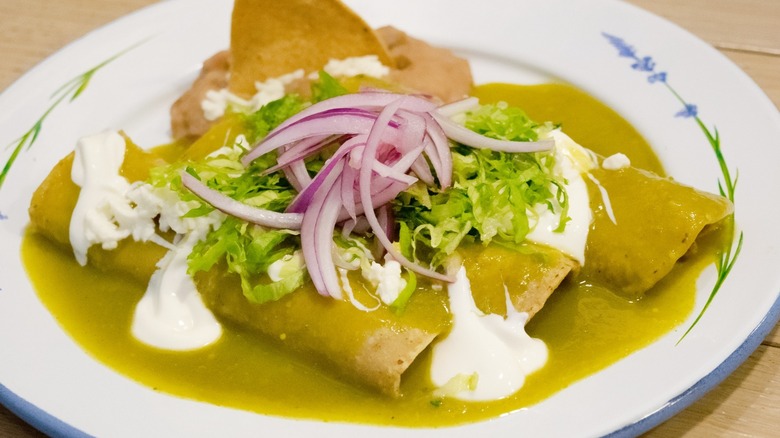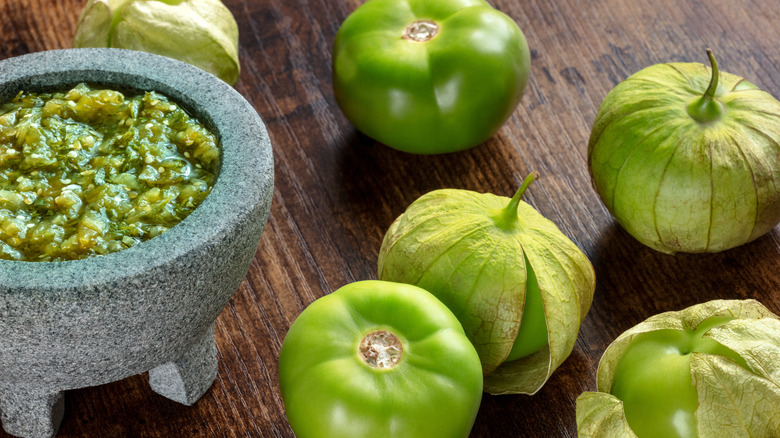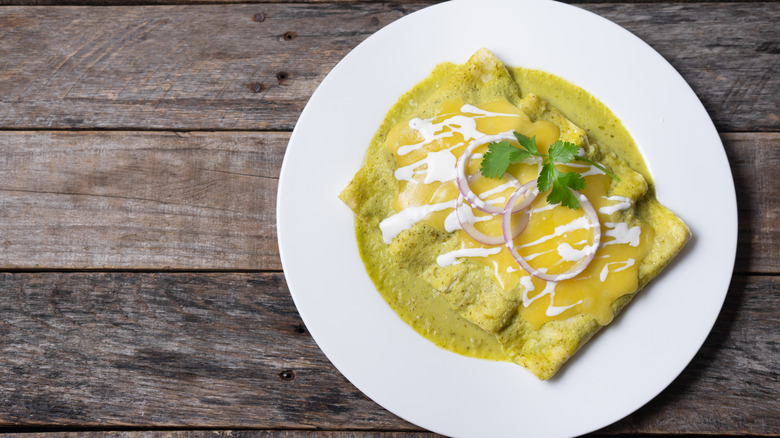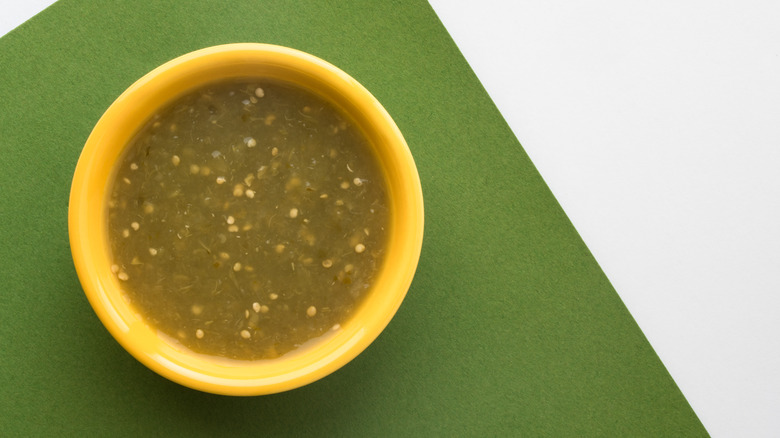How Green Enchilada Sauce Differs From Salsa Verde
Salsa verde, as anyone with even the smallest smattering of Spanish knows, means "green sauce," so you might think that, by extension, every verdant dressing might fall under its umbrella, or at least all such sauces with roots in a Spanish-speaking country. In a broader sense that might be true. But in restaurant menu and recipe terms, while salsa verde is a green sauce, not all green sauces are salsas verdes, not even the fairly similar green enchilada sauce.
The basic difference between the two sauces is that salsa verde tends to be what is known as a salsa cruda, meaning it is made from chopped, raw vegetables (more on those later) and other flavoring elements. Green enchilada sauce, or any enchilada sauce for that matter, is cooked and the different ingredients used to make it are blended together with water or some other type of liquid. The end result is a sauce that is thinner and smoother than the salsa verde, which can be quite thick and even chunky at times, depending on the saucier's preference.
Salsa verde has ancient roots
Salsa verde is typically made from tomatillos, which, despite their similar name, are an entirely different species (and genus) from red tomatoes. Tomatillos, which the Aztecs called miltomatl, were an important part of this Mexican civilization's diet. Their use was documented by Francisco Hernandez, court physician to Spain's King Philip II when he traveled to the New World in the late 16th century. In his writings he described a sauce that the indigenous Mexican people would make from chopped tomatillos mixed with chiles, thus documenting the first known use of salsa verde as a condiment.
A typical 21st-century salsa verde recipe may include not only tomatillos and chiles such as serranos or jalapeños, but onions, garlic, and cilantro. Additional green ingredients such as lime juice, avocados, or even lettuce may also be part of the mix. Although, as we previously mentioned, there is no need to cook any of the ingredients, there are some cooks who do prefer to pre-roast the tomatillos and chiles and in fact, our own salsa verde recipe includes such a step.
The history of green enchilada sauce is harder to pin down
Green enchilada sauce, unlike salsa verde, seems to have less of a provenance. Enchiladas themselves are another relic of Aztec foodways, although all we know of the originals is that they were dipped in a paste made of ground chiles, color unknown. The Mayans, however, had an enchilada-esque dish with a tomato sauce.
Today's enchilada sauce comes in two varieties, red and green. The former is made from dried red chiles boiled in broth with garlic and onions, while the latter is made from tomatillos cooked with chiles in liquid. It may include onions and garlic as well, along with green ingredients such as bell peppers, spinach, lime juice, and cilantro. While green enchilada sauce sometimes tends to be milder than red, it really depends on the types of chiles used. Typically red sauce is preferred with beef-filled enchiladas, whereas green chiles work with chicken enchilada recipes.
As to which came first, the red sauce or the green, some sources feel that red is the more traditional of the two. One food writer in the 1920s rhapsodized about the red-sauced enchiladas served at an Albuquerque restaurant, but the first specific reference to green enchilada sauce that we've been able to track down is in a 1976 Texas Monthly travel piece about dining in Mexico. The sauce may date back even earlier than that, though, as it's seemingly a featured component of enchiladas suiza, a dish created in 1950.
The two sauces can often be used interchangeably
Salsa verde and green enchilada sauce do have distinctively different tastes and textures, with the former being tarter, tangier, and thicker while the latter has a smoother, more savory flavor to it. Neither one is necessarily spicier than the other, at least in the sense of heat level, although the latter typically contains more seasonings. Still, they can be swapped out for one another in many instances. Green enchilada sauce, while thin, can still make for a great taco topper and even a chip dip. However, if you want to thicken it up in the latter instance you can always mix it with sour cream.
As for chile verde, if you wish to use it as a replacement in a recipe for chicken enchiladas or enchiladas suiza, you may certainly do so. In fact, you can even retrofit this sauce to the recipe by cooking it first and perhaps thinning it out with some bouillon or water and adding some black pepper, chili powder, cumin, and oregano. Taking these steps could turn the raw ingredients of chile verde into something fairly similar to green enchilada sauce.



